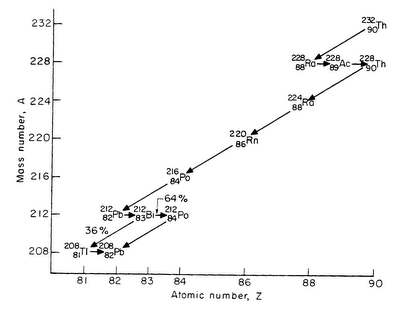Denaturing Thorium with Ionium
Bruce Hoglund has brought some very interesting information to my attention in recent months, that I wanted to talk about here.
Over the years, the strange beast of “proliferation” raises its head in various forms and fashions to afflict any reactor design. There are all different degrees in how it is interpreted and exercised. Some use the fact that fission bombs have fission reactions as an excuse to say that any nuclear reactor using fission material is a proliferation risk. On the opposite end of the spectrum, for years the nuclear community looked to a future “plutonium economy” where weapons-grade plutonium moved from fast breeder to reprocessing plant to sale on fuel markets.

Using thorium as the fertile material and U-233 as the fissile material has a secret advantage in the “proliferation” department–the inevitable formation of uranium-232. U-232 follows the same decay sequence as thorium-232, the only difference being that Th-232 takes 15 billion years for that first decay, whereas U-232 only takes about 78. The “4n” decay chain, of which U-232 and Th-232 both follow has a decay product (thallium-208) that emits a strong and penetrating gamma ray during its decay that makes it very unattractive in weapons use.
Weapons, especially those that want to be launched on ICBMs, can’t afford thick heavy gamma shielding around their fissile cores to protect the sensitive electronics that trigger detonation. So fissile material for weapons needs to emit easily-shielded radiation. Plutonium-239 and uranium-235 both fit the bill. Uranium-233 contaminated with uranium-232 does not.

So how do you get U-232 contamination? Well, in the core the predominant mechanism to form U-232 is an “n,2n” reaction with U-233, where U-233 is struck by a neutron and it then releases two neutrons, forming U-232.

But as I’ve talked about in other portions of this blog, in a two-fluid thorium reactor, thorium nuclei in the blanket will intercept neutrons and breed–first to protactinium-233, then to uranium-233. If the protactinium is isolated chemically after it is formed, then the U-233 in the protactinium decay tank will have little U-232 contamination.
The real question I’ve had is: how can we generate U-232 contaminated material, even in the Pa decay tank?
The answer may well be ionium.

Ionium isn’t really an element–it’s one of those names that was given to an isotope before it was recognized as an isotope. Ionium is thorium-230, which is part of the natural decay chain of uranium-238, which is rather abundant. Thus one could expect to find ionium in uranium tailing piles.

When ionium is exposed to neutrons, it first forms protactinium-231, and then another neutron absorption forms uranium-232. If the thorium in the blanket was “spiked” with ionium, it would be impossible to chemically separate the two forms of thorium (since they are chemically identical) but the ionium would preferentially absorb neutrons and form Pa-231. Another neutron absorption and you would have U-232. Both Pa-231 and U-232 would be collected by the reductive extraction technique used to remove protactinium from the blanket and would thus end up in the Pa decay tank. Now as Pa-233 decayed to U-233, there would be substantial U-232 contamination, and any weapons risk could be eliminated.

Collecting ionium from uranium tailings should not be particularly difficult since it is chemically distinct from uranium. It won’t take much ionium in the thorium-232 to “spike” it, and the small quantities should have little effect on the overall neutronics. Thorium reactors could certify that they were running on ionium-spiked thorium through a quick fuel examination in a mass spectrometer.
Lacing thorium with ionium could prove to be a much more attractive option than some of the others proposed, such as fueling the reactor on “denatured” uranium, which leads to the formation of transuranics and drastically compromises the ability of the reactor to breed and reprocess.

The the scenario thorium opponents typically pose is one where Pa-232 and Pa-233 are chemically extracted, Pa-232 decays quickly because of its short half-life leaving "enriched" Pa-233 (which has not decayed as much) and this process can be repeated until desired levels of Pa-233 purity are reached. However improbable that might be, it looks theoretically possible. Am I correct in assuming this spiking strategy would do nothing to obviate that approach to Pa-233 enrichment?
You make a good point, but isn't the whole point of U-232 to make handling the fuel craptastically hazardous? in such a circumstance it's true that the Pa-232 would decay faster than Pa-233, but that would essentially contaminate the Pa-233 decay tank with U-232, this would mean you would need to continuously remove U-232 as it formed from the decay tank, a pretty hazardous endeavour in itself.
But suppose you keep chemically pulling the Pa-233 out of the decay tank until you run out of Pa-232, I guess there is some merit in that train of though (disregarding the need to handle the U-232).
However I should point out that you would need to custom build the decay tank system to specifically achieve such a process , and I think that build would not be lost on international inspectors, especially since they are supposed to turn up every now and to take mass spectrometry samples to ensure that your fuel is Ionium spiked.
What we are concerned about is a system that would separate pure weaponisable fissile material undetected through a normal and internationally accepted design and normal operations in significant enough quantities to build a bomb. Which in this case remains impossible since you need really obvious mechanisms to achieve this mode of Pa-233 separation in the decay tank.
Please correct me if I made any mistakes in my assumptions